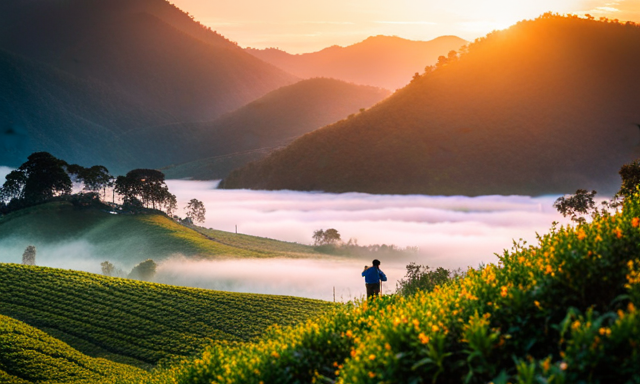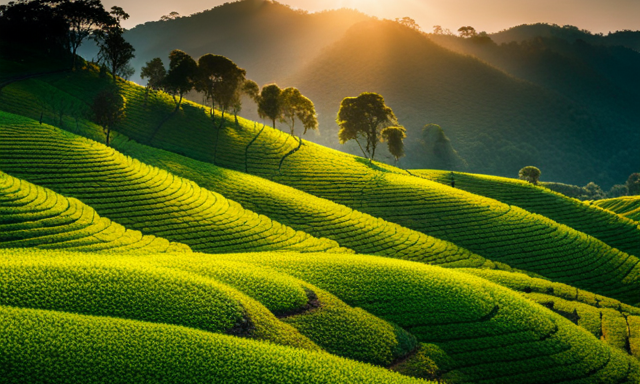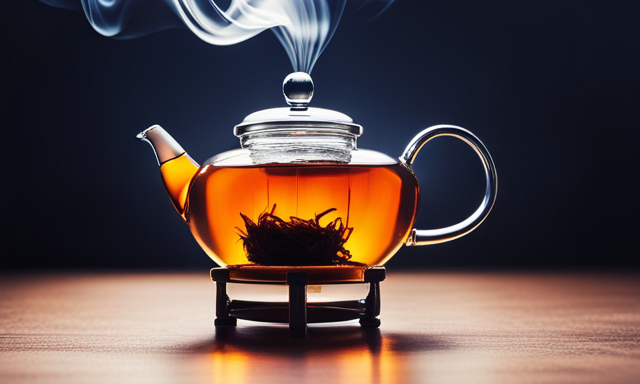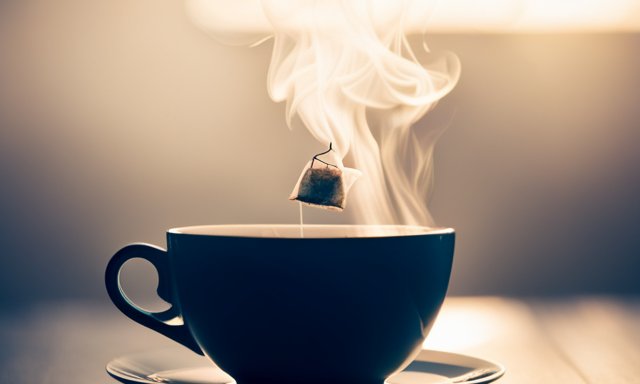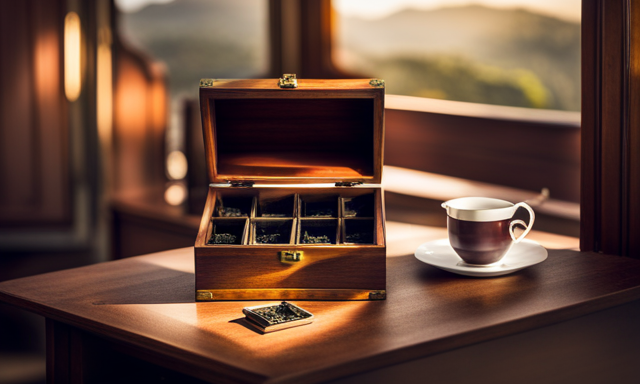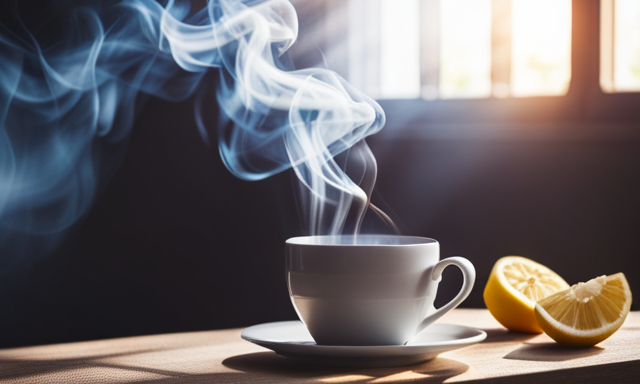Have you ever pondered about the origins of oolong tea? Allow me to shed some light on it.
Oolong tea comes from a remarkable plant called Camellia Sinensis. This plant is the source of all true teas, including black, green, and white tea. But what sets oolong tea apart is its unique processing method, which lies somewhere between green and black tea.
The Camellia Sinensis plant, with its lush green leaves and delicate aroma, is cultivated in various regions around the world, including China, Taiwan, and India, each imparting their own distinct flavors to the tea.
From plucking the leaves to the intricate process of withering, rolling, and oxidizing, oolong tea production is a labor of love. The resulting tea is a perfect balance of floral and fruity notes, with a hint of earthiness.
Not only does oolong tea offer a delightful taste experience, but it also boasts numerous health benefits. So, join me on a journey to explore the fascinating world of oolong tea and discover why it has captured the hearts of tea enthusiasts worldwide.
Key Takeaways
- Oolong tea comes from the Camellia Sinensis plant, which is the source of all true teas.
- The Camellia Sinensis plant is an evergreen shrub native to East Asia and is cultivated in China, Taiwan, and India for oolong tea production.
- The leaves of the Camellia Sinensis plant undergo partial oxidation and withering to produce oolong tea, resulting in a balance of floral, fruity, and earthy flavors.
- Factors such as cultivar and growing conditions of the Camellia Sinensis plant impact the flavor and aroma of oolong tea.
The History of Oolong Tea
The history of oolong tea dates back to the early 18th century in Fujian province, China. It is believed that oolong tea was first produced by accident when a tea farmer forgot about his tea leaves and they oxidized more than usual. This accidental discovery led to the creation of a whole new category of tea.
Today, there are different varieties of oolong tea, each with its own unique flavor profile and production methods. Some popular types include Tie Guan Yin, Da Hong Pao, and Oriental Beauty. These teas vary in taste, color, and aroma, catering to different preferences.
Now, let’s delve into the camellia sinensis plant: the source of oolong tea.
The Camellia Sinensis Plant: The Source of Oolong Tea
The Camellia Sinensis plant is a species of evergreen shrub native to East Asia. It is cultivated in various regions, including China, Taiwan, and India, for oolong tea production. The plant thrives in tropical and subtropical climates, and its cultivation requires specific techniques to ensure the highest quality tea leaves.
The leaves of the Camellia Sinensis plant are carefully harvested and undergo a unique process of partial oxidation and withering to produce oolong tea. This technique gives oolong tea its distinct flavor and aroma, which can vary depending on factors such as the specific cultivar and growing conditions.
Understanding the characteristics of the Camellia Sinensis plant is essential to appreciating the art of oolong tea production.
Characteristics of the Camellia Sinensis Plant
The characteristics of the Camellia Sinensis plant include vibrant green leaves that dance in the breeze like emerald jewels. This plant thrives in regions with specific climatic conditions, such as high altitudes and moderate temperatures. The geographical distribution of the Camellia Sinensis plant spans across various countries, including China, Taiwan, and India. Each region imparts its unique characteristics to the tea leaves, resulting in a diverse range of oolong teas. Cultivation techniques, such as precise pruning and harvesting methods, play a crucial role in ensuring the quality of oolong tea. These techniques contribute to the development of complex flavors and aromas. Understanding the intricacies of the Camellia Sinensis plant and its cultivation is essential in producing exceptional oolong teas. Now, let’s delve into how oolong tea is produced.
How Oolong Tea is Produced
To produce oolong tea, farmers carefully cultivate and harvest the leaves of the Camellia Sinensis plant, employing traditional techniques that have been passed down through generations. The unique flavor and characteristics of oolong tea are a result of the intricate fermentation process and production techniques. After the leaves are plucked, they are withered under the sun to remove moisture. Then, the leaves undergo a unique process called bruising, where they are shaken or rolled to break the cell walls and start the oxidation process. The oxidation is carefully monitored and stopped at a specific point to achieve the desired flavor profile. Lastly, the leaves are dried to halt fermentation and preserve the tea’s aroma and taste. This meticulous process enhances oolong tea’s complex flavors and creates a delicate balance between the characteristics of black and green tea. Moving on to the next section, let’s explore the different varieties of oolong tea.
Different Varieties of Oolong Tea
There are various types of oolong tea, each with its own unique flavors and characteristics, allowing tea enthusiasts to indulge in a world of diverse taste experiences.
Oolong tea flavors can range from floral and fruity to toasty and nutty. Some popular varieties include Tie Guan Yin, Da Hong Pao, and Oriental Beauty.
Tie Guan Yin, grown in the Fujian province of China, has a delicate and floral taste.
Da Hong Pao, from the Wuyi Mountains in China, is known for its rich and roasted flavor.
Oriental Beauty, produced in Taiwan, offers a sweet and fruity profile.
These different oolong tea flavors are influenced by the specific regions where the tea leaves are grown and processed.
Now, let’s explore the flavor profile of oolong tea.
The Flavor Profile of Oolong Tea
Indulge your taste buds with the exquisite flavor profile of oolong tea. It offers a sensory journey that will transport you to a world of floral, fruity, toasty, and nutty notes.
When it comes to flavor variations, oolong tea has a wide range of options to suit every palate. From delicate and floral to rich and robust, there is a flavor profile for everyone.
The brewing techniques also play a crucial role in unlocking the full potential of oolong tea’s flavors. Whether you prefer a shorter steeping time for a lighter taste or a longer infusion for a bolder flavor, experimenting with brewing methods can enhance your oolong tea experience.
As we delve into the health benefits of oolong tea, the journey continues with a deeper understanding of its positive effects on our well-being.
Health Benefits of Oolong Tea
Now that we’ve explored the delightful flavor profile of oolong tea, let’s delve into its numerous health benefits.
Oolong tea is not only a delicious beverage, but it also offers a range of advantages for your well-being. Its rich antioxidant content helps combat free radicals, reducing the risk of chronic diseases such as heart disease and cancer.
Additionally, oolong tea has been shown to boost metabolism and aid in weight management. It can also improve brain function, promote healthy skin, and strengthen the immune system.
To fully enjoy these health benefits, it’s important to brew oolong tea correctly. The brewing techniques can vary depending on the specific type of oolong tea, so it’s crucial to follow the recommended steeping times and water temperatures. By mastering the art of brewing, you can unlock the full potential of oolong tea.
Now, let’s move on to the next section and discover some brewing tips for the perfect cup of oolong tea.
Brewing Tips for the Perfect Cup of Oolong Tea
Get ready to elevate your tea experience with these mind-blowing brewing tips that will take your cup of oolong tea to a whole new level of perfection!
When it comes to brewing oolong tea, the right technique makes all the difference. Start by using fresh, filtered water and bring it to a temperature around 190°F.
Steep the tea leaves for about 3-5 minutes, but keep in mind that the steeping time can vary depending on the desired flavor intensity. Experiment with different steeping times to find your perfect balance.
Oolong tea offers a wide range of flavors, from floral and fruity to toasty and nutty. Explore the diverse flavor profiles by trying different varieties of oolong tea.
With these brewing techniques, you’ll unlock the full potential of oolong tea’s rich and complex flavors.
Now, let’s dive into the world of popular oolong tea blends and infusions.
Popular Oolong Tea Blends and Infusions
Explore the world of popular oolong tea blends and infusions to embark on a journey of exquisite flavors that will captivate your taste buds.
Oolong tea offers a wide range of flavors, from floral and fruity to toasty and nutty. One popular blend is the Jasmine Oolong, which combines the fragrant essence of jasmine flowers with the smooth and mellow taste of oolong tea.
For a unique twist, try a Milk Oolong, known for its creamy and sweet flavor profile.
To enhance the flavors of oolong tea, it is important to use the right brewing techniques. Start with water that is around 195°F and steep the tea leaves for 3-5 minutes. This will ensure a balanced and flavorful cup of oolong tea.
Now, let’s delve into the cultural significance of oolong tea.
Exploring the Cultural Significance of Oolong Tea
Immerse yourself in the rich cultural heritage of oolong tea, where centuries-old traditions and rituals intertwine with the art of brewing and savoring this beloved beverage. Oolong tea holds a special place in various cultural traditions, especially in China and Taiwan. These traditions are often showcased through oolong tea ceremonies, which are elegant and intricate affairs that highlight the beauty and significance of this tea.
Here are some key aspects of the cultural traditions surrounding oolong tea:
-
Tea Masters: Highly skilled tea masters are revered for their expertise in brewing and serving oolong tea. They have dedicated their lives to perfecting the art of tea making and conducting ceremonies.
-
Rituals and Etiquette: Oolong tea ceremonies follow specific rituals and etiquette, emphasizing respect and mindfulness. Proper handling of the tea leaves, utensils, and serving tea in a particular order are all essential elements.
-
Symbolism: Oolong tea is often associated with harmony, balance, and tranquility. Its preparation and consumption are seen as a way to connect with nature and find inner peace.
-
Tea Ware: Specialized tea ware, such as clay teapots and cups, are used in oolong tea ceremonies. These utensils are chosen carefully for their ability to enhance the taste and aroma of the tea.
-
Social Bonding: Oolong tea ceremonies also serve as a means of social bonding. People gather together to enjoy the tea, engage in conversations, and appreciate the beauty of the ceremony.
Participating in an oolong tea ceremony allows one to experience the depth of cultural traditions surrounding this exquisite beverage. It is a captivating journey that combines history, art, and mindfulness, making oolong tea not just a drink but a cultural treasure.
Frequently Asked Questions
What is the caffeine content of oolong tea?
The caffeine content of oolong tea varies depending on the specific type and brewing method, but it generally contains around 30-50 mg per cup. In addition to its moderate caffeine content, oolong tea offers numerous health benefits.
Does oolong tea have any antioxidant properties?
Oh, the wonders of oolong tea! Not only does it offer a delightful taste, but it also boasts antioxidant benefits that contribute to its impressive array of health benefits.
Can oolong tea help with weight loss?
Oolong tea can help with weight loss by boosting metabolism and aiding in appetite control. Its unique combination of catechins and caffeine increases fat oxidation and thermogenesis, leading to potential weight management benefits.
How should oolong tea be stored to maintain its freshness?
To maintain the freshness of oolong tea, I recommend following these storage tips. Store it in an airtight container, preferably made of ceramic or glass, in a cool, dark place away from moisture and strong odors.
Are there any potential side effects or risks associated with consuming oolong tea?
There are no significant side effects or risks associated with consuming oolong tea. It offers potential health benefits like improved heart health and weight management. The recommended daily intake is 2-3 cups.
Conclusion
In conclusion, oolong tea is derived from the Camellia Sinensis plant. This plant possesses unique characteristics that contribute to the distinct flavor and aroma of oolong tea. The production process involves a careful balance of oxidation and fermentation, resulting in a variety of oolong tea types.
Aside from its delightful taste, oolong tea also offers numerous health benefits. So, why not indulge in a cup of this exquisite tea and let its flavors dance on your palate like a symphony of sensations?

